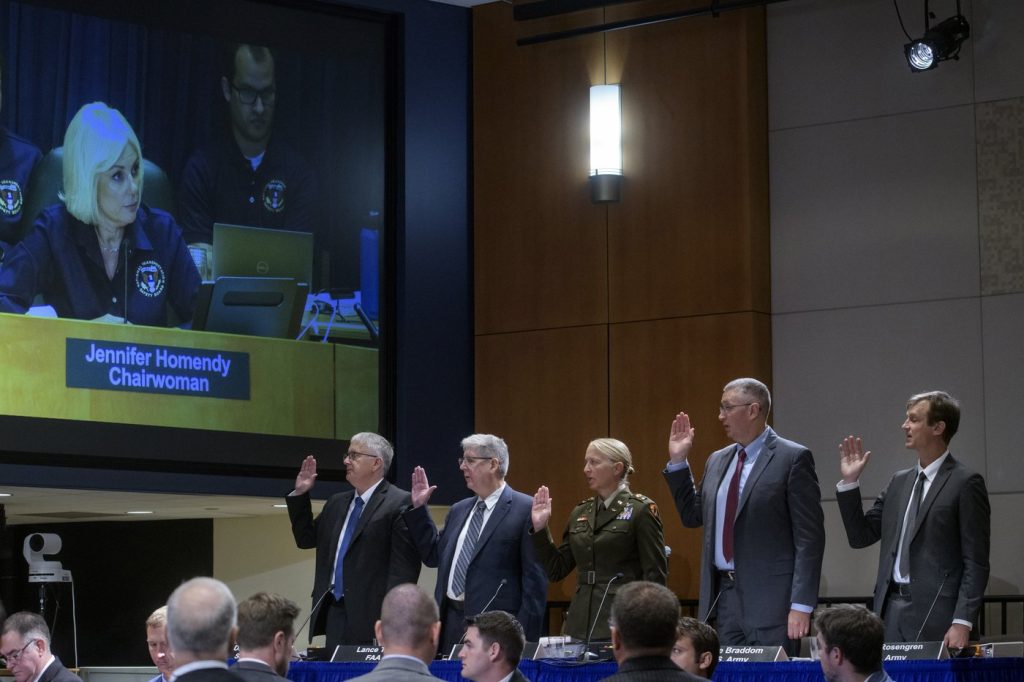The National Transportation Safety Board (NTSB) is currently conducting a second day of public hearings to investigate the midair collision that occurred in January between an Army Black Hawk helicopter and a passenger plane, resulting in the tragic loss of all 67 individuals on board both aircraft. The hearings aim to uncover the contributing factors leading to this incident, which marks the deadliest aviation accident in the United States since November 2001.
During the initial day of hearings, investigators detailed numerous elements that may have played a role in the crash. They emphasized prior warnings issued to the Federal Aviation Administration (FAA) regarding helicopter traffic near the Potomac River, which had been raised in discussions years before this catastrophic event. Although it remains premature for the board to conclusively determine the exact cause of the crash, the hearings highlighted the critical margin of error for helicopters on the flight path taken by the Black Hawk.
The collision, which occurred in January, has been linked to a series of alarming aviation incidents, including both crashes and near misses in the aviation sector this year. Even with these challenges, official statistics indicate that air travel continues to be the safest method of transportation. Concerns have escalated regarding FAA's prior acknowledgment of high helicopter traffic around Ronald Reagan National Airport and the associated risks of collisions.
NTSB Chairwoman Jennifer Homendy pointed out that a working group within the FAA had expressed worries in 2022 about potential collision risks due to helicopter traffic, yet the FAA declined to include a warning on helicopter navigation charts advising pilots to exercise caution during landing operations on the runway in question. Homendy noted, "This is the very event that this would have been the cautionary note for."
Investigations revealed that the helicopter involved in the crash operated above the 200 feet altitude limit before its unfortunate collision. The flight data recorder indicated that the helicopter was 80 to 100 feet higher than what its barometric altimeter displayed. To further substantiate this finding, the NTSB conducted tests on three other helicopters from the same unit, discovering similar discrepancies in their altimetry readings.
Dan Cooper, representing Sikorsky helicopters, explained that the Black Hawk model involved in the incident was designed in the 1970s and utilized an altimeter technology prevalent at the time. In contrast, more modern helicopters are equipped with air data computers, which provide enhanced accuracy for altitude measurements. Chief Warrant Officer Kylene Lewis stated she wouldn't find discrepancies of 80 to 100 feet alarming, as, at lower altitudes, pilots typically rely on radar altimeter readings and cross-check them against barometric altimeters.
Army officials mentioned that a discrepancy of 70 to 100 feet between altimeters is considered acceptable, as pilots maintain altitude within that range. However, significant concerns arose regarding the FAA's approval of helicopter and airplane routes around Reagan Airport that allow for minimal separation between helicopters and landing planes, prompting remarks from Army Chief Engineer Scott Rosengren about the risks posed by such close distances.
Prior to the crash, one air traffic controller was managing the communications of multiple aircraft, including the Black Hawk helicopter, various other airplanes taking off and landing, and other helicopters. The NTSB's research indicated that communication challenges arose as helicopters could only hear other helicopters on their frequency while airplanes could only communicate with other airplanes. This led to instances of "stepped on transmissions," wherein critical information was lost amid overlapping communications. A recent report indicated a concerning number of 29 distinct communications between the airport tower and other aircraft occurred in just under two minutes leading up to the collision.
Confirmation from previously reviewed air traffic control audio captured the helicopter pilot communicating to the controller that they had sighted the airplane and were taking evasive maneuvers. The animation presented during the hearings culminated with distressing surveillance footage showing the devastating crash between the helicopter and the plane.
The ongoing investigation has uncovered that the FAA failed to respond adequately to a history of 85 near misses reported around Ronald Reagan National Airport prior to the collision. Additionally, it was revealed that Army helicopters routinely operated without a critical locating device known as ADS-B Out switched on, further exacerbating safety concerns in the airspace above the nation’s capital.










